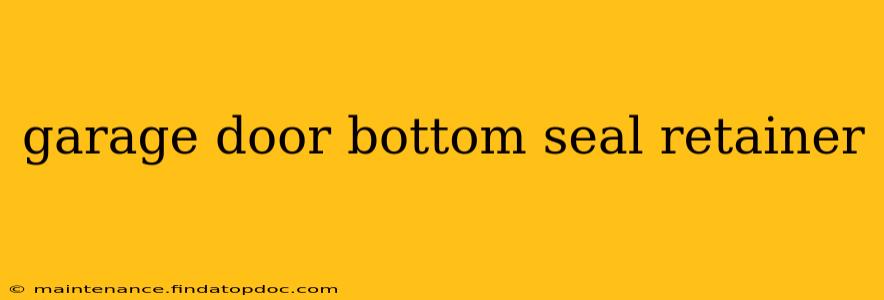Garage doors are essential for protecting your home and belongings, and maintaining their functionality is crucial. A significant component of a well-functioning garage door is the bottom seal, which keeps out drafts, pests, and water. However, this seal wouldn't stay in place without the often-overlooked garage door bottom seal retainer. This guide dives deep into understanding this crucial part and addresses common concerns homeowners have.
What is a Garage Door Bottom Seal Retainer?
The garage door bottom seal retainer is a crucial component that holds the rubber or vinyl bottom seal in place along the bottom edge of your garage door. It's typically a metal extrusion—sometimes aluminum, sometimes steel—that runs the entire length of the door. The seal slips into a groove or channel within this retainer, keeping it securely fastened even as the door moves up and down. Without a properly functioning retainer, your seal can become dislodged, leading to various problems.
Why is the Garage Door Bottom Seal Retainer Important?
The retainer's importance can't be overstated. It directly impacts the effectiveness of the bottom seal, ensuring its consistent contact with the ground, preventing:
- Drafts and Energy Loss: A loose or damaged seal lets cold air in during winter and hot air out in summer, significantly impacting your energy bills.
- Pest Infestation: Gaps created by a displaced seal provide easy access for insects, rodents, and other pests.
- Water Damage: Rain, snow, and melting ice can seep into your garage, causing damage to your belongings and potentially leading to mold growth.
- Noise: A loose seal can lead to increased noise levels as the door operates.
How to Identify Problems with the Garage Door Bottom Seal Retainer?
Several signs indicate problems with your garage door bottom seal retainer:
- Loose or Detached Seal: The most obvious sign is a seal that's come loose or detached from the retainer. You might see gaps between the seal and the garage door.
- Bent or Damaged Retainer: Inspect the retainer itself for bends, cracks, or other damage. Impact from objects or general wear and tear can cause damage.
- Seal Deterioration: While not directly a retainer problem, a significantly deteriorated seal might indicate the retainer isn't holding it properly.
How to Replace a Garage Door Bottom Seal Retainer?
Replacing a garage door bottom seal retainer is generally a straightforward process, but it does require some basic DIY skills. Here's a general outline:
- Assess the Damage: Determine the extent of the damage and whether you need to replace the entire retainer or just a section.
- Purchase a Replacement: Measure the length of your garage door and find a compatible replacement retainer at a home improvement store.
- Remove the Old Retainer: Carefully remove the old retainer using appropriate tools. This might involve unscrewing fasteners or prying it loose.
- Install the New Retainer: Secure the new retainer in place, ensuring it is correctly aligned and firmly attached.
- Install the New Seal: Once the retainer is installed, slide the new seal into the groove.
Note: If you are uncomfortable performing this repair yourself, it's best to consult a professional garage door technician.
What are the Different Types of Garage Door Bottom Seal Retainers?
While the basic function remains the same, there are variations in materials and designs:
- Aluminum Retainers: These are lightweight and corrosion-resistant, making them a popular choice.
- Steel Retainers: Steel retainers offer greater durability but are heavier.
- Different Groove Designs: The shape and size of the groove within the retainer can vary slightly, affecting the type of seal that's compatible.
Can I repair a damaged garage door bottom seal retainer instead of replacing it?
Minor damage to the retainer, like small dents, might be repairable through careful bending or straightening. However, significant damage usually warrants replacement for optimal performance and longevity.
How often should I inspect my garage door bottom seal retainer?
Regular inspection, at least once a year, is recommended. During the inspection, check for any signs of damage, looseness, or wear and tear to the retainer and seal. This preventative maintenance can save you from larger problems and expenses in the long run.
This comprehensive guide should provide you with the knowledge needed to understand and maintain your garage door bottom seal retainer. Remember to prioritize safety and seek professional assistance if needed.
